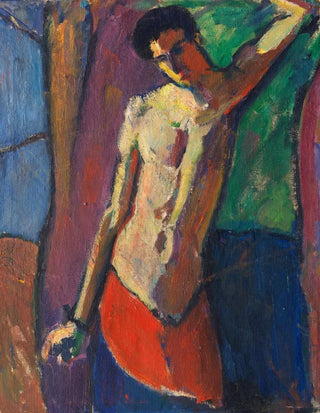Art print | Saint Sebastian - Hermann Stenner


View from behind

Frame (optional)
Saint Sebastian - Hermann Stenner – Captivating Introduction
The artwork "Saint Sebastian" by Hermann Stenner is a masterpiece that transcends the simple frame of painting to become a true testament to human emotion and spirituality. In this poignant representation, the artist manages to capture the very essence of the Christian martyr, whose body, both suffering and majestic, seems to defy death. The composition, both dynamic and serene, invites the viewer to a deep contemplation, where nuances of light and shadow play a fundamental role. The strength of this piece lies in its ability to evoke universal feelings such as pain, faith, and resilience, while remaining rooted in a rich historical context.
Style and uniqueness of the work
Hermann Stenner's style is distinguished by a bold and innovative approach that blends influences of symbolism and post-impressionism. In "Saint Sebastian," the artist uses vivid colors and expressive forms to create an atmosphere that is both dramatic and spiritual. The meticulous details of the saint's body, accentuated by plays of light, reveal a virtuoso technique that demonstrates his skill in capturing the essence of his subjects. The saint's posture, both vulnerable and strong, evokes a fascinating duality, reinforced by the surrounding elements that seem to vibrate with palpable energy. This work stands out not only for its technique but also for its profound message, which still resonates today in our quest for meaning and understanding.
The artist and his influence
Hermann Stenner, an emblematic figure of the early 20th century, established himself as a visionary artist whose work continues to influence subsequent generations. Born in Germany, he was deeply marked by the upheavals of his time, which fueled his creativity and artistic reflection. Stenner explored various themes, ranging from spirituality to the human condition, and his unique style contributed to redefining the aesthetic norms of his era. By integrating elements of popular culture and historical references, he managed to establish a dialogue between the past and the present, enriching

Matte finish

View from behind

Frame (optional)
Saint Sebastian - Hermann Stenner – Captivating Introduction
The artwork "Saint Sebastian" by Hermann Stenner is a masterpiece that transcends the simple frame of painting to become a true testament to human emotion and spirituality. In this poignant representation, the artist manages to capture the very essence of the Christian martyr, whose body, both suffering and majestic, seems to defy death. The composition, both dynamic and serene, invites the viewer to a deep contemplation, where nuances of light and shadow play a fundamental role. The strength of this piece lies in its ability to evoke universal feelings such as pain, faith, and resilience, while remaining rooted in a rich historical context.
Style and uniqueness of the work
Hermann Stenner's style is distinguished by a bold and innovative approach that blends influences of symbolism and post-impressionism. In "Saint Sebastian," the artist uses vivid colors and expressive forms to create an atmosphere that is both dramatic and spiritual. The meticulous details of the saint's body, accentuated by plays of light, reveal a virtuoso technique that demonstrates his skill in capturing the essence of his subjects. The saint's posture, both vulnerable and strong, evokes a fascinating duality, reinforced by the surrounding elements that seem to vibrate with palpable energy. This work stands out not only for its technique but also for its profound message, which still resonates today in our quest for meaning and understanding.
The artist and his influence
Hermann Stenner, an emblematic figure of the early 20th century, established himself as a visionary artist whose work continues to influence subsequent generations. Born in Germany, he was deeply marked by the upheavals of his time, which fueled his creativity and artistic reflection. Stenner explored various themes, ranging from spirituality to the human condition, and his unique style contributed to redefining the aesthetic norms of his era. By integrating elements of popular culture and historical references, he managed to establish a dialogue between the past and the present, enriching






